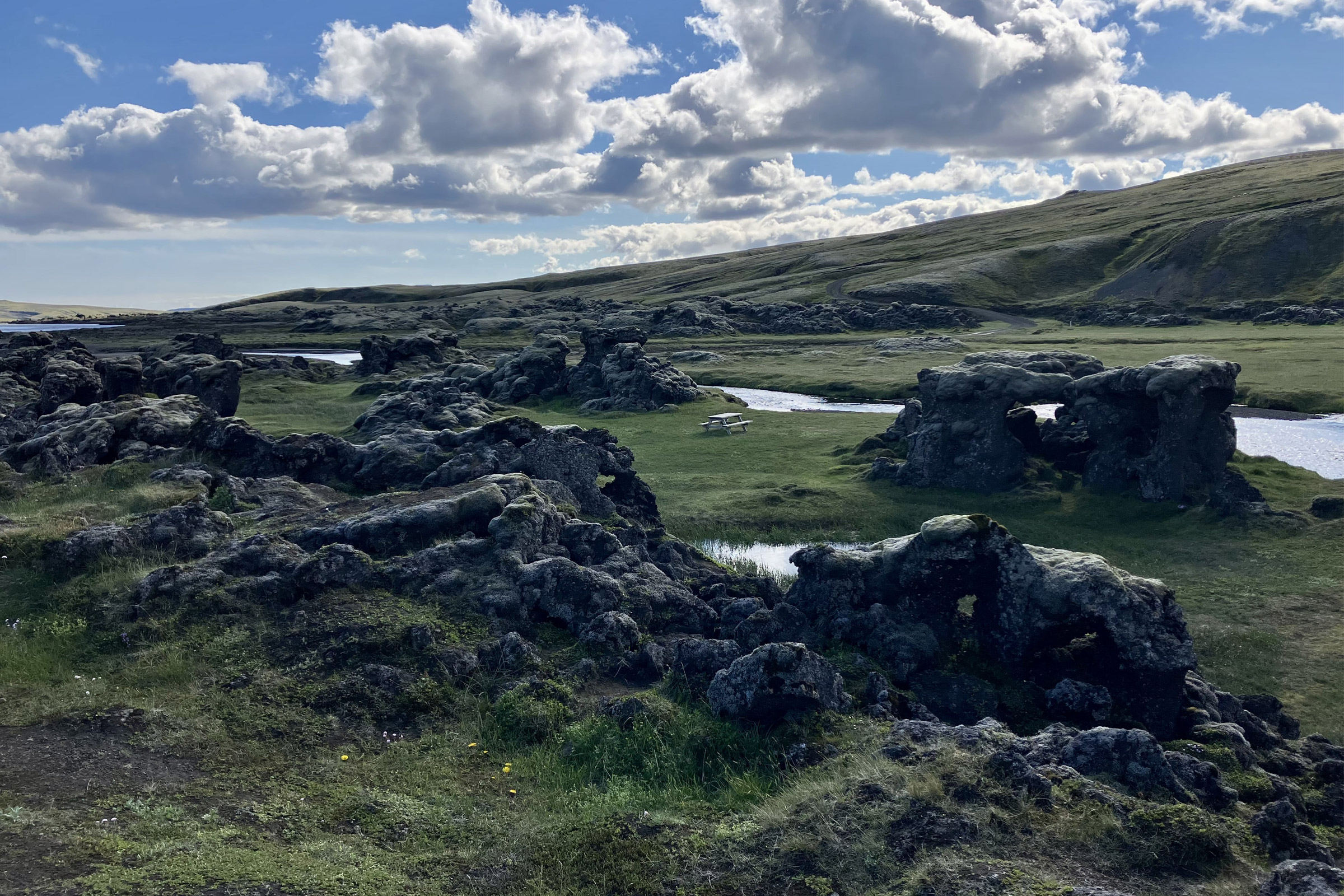Home to three times more sheep than people, Iceland may seem like a hiker and backpacker’s paradise. In some ways it is, and in some ways it isn’t.
If you stick to the popular trails in Iceland, you’ll be treated to breathtaking views, but you’ll also find yourself navigating throngs of like-minded tourists to reach them. Spanning 103,592 square kilometers, Iceland has plenty of open space and empty trails — you just have to know where to look.
Home to volcanoes, geysers, hot springs, glaciers, and lava fields, Iceland’s landscape is unlike any other and has topped my bucket list for years. After doing some research, I decided to sign up for a guided backpacking trip. The trip I chose was through Amarok Adventures entitled ‘Hidden Trails’ and was all about exploring Iceland’s lesser-known trails.
As someone who prefers to steer clear of the crowds and get deep into the backcountry, it seemed like the perfect fit.

First Impressions
Upon touching down in the land of fire and ice, my first impression was that it was cold. So, so cold. But it was also incredibly beautiful. After linking up with my hiking group, we set out for Landmannalaugar and the famous Laugavegur trail.
While the scenery was stunning, the trail and the backcountry hut we stayed in were busy. After 2 days of exploring Landmannalaugar and the surrounding area, we left the crowds behind and headed to more remote trails.
The Hidden Trails trip was a 12-day trek, hiking hut to hut throughout Iceland’s highlands. Because the trip was guided, our food was planned and dropped for us, making planning and packing a bit easier.
Throughout the 12 days, we ventured to some of the most beautiful places I have ever seen. Oftentimes, we found ourselves entirely alone, and the sense of awe I felt was unparalleled.

I am grateful to my guide and Amarok Adventures for showing us the off-the-beaten-path routes. Because of the huts, there are access roads to most of the trails, so they can easily be done as day or multiday hikes.
Here are a few favorites.
My Favorite ‘Hidden’ Trails
Grænihryggur, aka ‘Green Ridge’

Located in Fjallabak Nature Reserve, the hike to the Green Spine is one of the most impressive in the country. The trailhead is located a short drive from Landmannalaugar and round trip, the hike is approximately 10.5 miles — it’s fairly slow going, so allow about 8 hours to complete the hike.

En route to the Green Ridge, you’ll pass moss-covered valleys, rhyolite mountains, frigid river crossings, glaciers, and stunning canyons, ultimately ending at the impressive Green Ridge. Over the day-long hike, we didn’t see a single person, and the landscape was beautiful and the quiet refreshing. Although this hike could be done alone, it is probably best done with a guide as navigation could be challenging.
Sveinstindur Peak

This hike can easily be done as a day hike or as part of a longer thru-hike. If you’re planning to hike to Sveinstindur Peak, your best bet is to stay in Langisjór and then use a 4×4 vehicle to access the trail.
The trail is well-marked, and the moderate hike is a little over 7 miles if you do it as a thru-hike between huts. If you prefer a day hike, simply turn around at the peak and backtrack to where you began.
If you want to extend your initial hike, the mileage between huts is 7.5 miles. At the top of the peak, you’ll be treated to panoramic views of Lakagígar (the Laki craters), the Langisjór lake, the Vatnajökull glacier, and the Fjallabak area.
Skaelingar

If you have a vehicle capable of reaching Skaelingar, I highly recommend you visit. A lava field located along the Skafta river, Skaelingar feels like something out of a movie.
There are funky lava rock structures, vibrant moss fields, black sand desserts, glacial rivers, towering mountains, and so much more. Set off in any direction from the mountain hut and you’re sure to be amazed.

Despite the road access, Skaelingar feels incredibly remote and is an amazing way to unplug. If you’re feeling brave, take a plunge in the river to clean up after a day of hiking. If you’re looking to do a thru-hike, venture 10 miles to Holaskjol.
The total distance for hikes in the area varies, but it’s roughly 12 miles hut to hut.
Holaskjol to Alftavotn

When you first leave the mountain hut at Holaskjol, you’ll likely encounter some folks exploring the trail and checking out the nearby waterfall. But after a mile or so, you’ll quickly leave the crowds behind.
The path hugs the river, with a few chilly crossings along the way. After approximately 4 miles, you’ll reach Alftavotn, where there are beautiful lakes, a waterfall, and a lush, green valley. From there, you have the option to stay at a mountain hut or return to Holaskjol. Mileage hut to hut for this hike is 6.5 miles.

The Gear I Used: Recommended Gear List
When backpacking, especially in colder weather, having the proper gear is essential. Before heading to Iceland, I thoroughly researched different brands and products to ensure that my gear would keep me warm and safe, even in the most trying conditions. Here are a couple of recommendations that worked for me for this specific trek.

Hard Gear
Osprey Ariel 55
This women’s-specific pack is equal parts comfortable and functional, making it perfect for long days on the trail. It has plenty of storage space, easy-access pockets for essentials, a space for a hydration pack and water bottles, and an adjustable hipbelt and shoulder straps.
Big Agnes Fly Creek HV UL1 or Mountain Hardwear Nimbus UL 2 Tent
Although we mainly stayed in backcountry huts, I liked the option of a tent for nights when I preferred to be outside. The Fly Creek one-man tent is insanely lightweight, easy to set up, and is weatherproof and waterproof. It has plenty of interior space and packs down small, so it’s easy to attach to your pack.
If you have a buddy, the Nimbus UL 2 Tent is the call. The UL 2 is lightweight and packable and features a front dry-entry vestibule, three-quarter mesh canopy for stargazing, reinforced webbing corners, high-quality stakes, DAC Featherlight NFL poles, and a sil-nylon rainfly, making it perfect for life on the move.
Big Agnes Sidewinder SL 20
As a side sleeper, I’m a big fan of the Big Agnes Sidewinder sleeping bag. Designed for comfort all night long, this sleeping bag is warm, packs down small, and allows you to roll back and forth with ease.

Apparel
Marmot Kessler Jacket
The weather is incredibly mercurial in Iceland and can go from sunshine to rain in the span of 10 minutes. Having a good rain jacket is a must, and the Kessler jacket kept me dry throughout the duration of the trip while simultaneously doubling as a windbreaker. Made from GORE-TEX active fabric, the jacket has plenty of pockets, adjustable cuffs, and pit zips for ventilation when it does warm up.
Mountain Hardwear Stretch Ozonic Pant
Like the rain jacket, having a solid pair of waterproof pants is essential for hiking in wet conditions. These pants are lightweight, have an elastic waistband, and have zippers up the sides, making them breathable and easy to pull on and off as needed. They also worked well to protect me from the biting wind, and I ended up wearing them on cold days, wet or dry.
Mountain Hardwear Stretch Tank
Although it was too cold to hike in a tank, the Stretch Tanklette was a great bottom layer and a good option for warmer nights in the hut. This tank has a flattering fit, and the warp-knit fabric works to efficiently wick sweat away.
Marmot Mariposa Short-Sleeve & Long-Sleeve
Made from an ultralight polyester knit blend, the Mariposa was perfect for hiking in, as it was breathable, wicked away sweat, and dried quickly. The Microban-treated fabric also helped keep the stink away, which was much appreciated on a 12-day trip. I alternated between the short- and long-sleeve depending on the weather.
Marmot Mountain Active Tight
When you spend 12 days hiking in cold weather, a solid pair of tights is a must. Featuring lightweight, stretchy fabric, a three-layer waistband, zippered hand pockets, and UPF 50+ protection, the Mountain Active tights kept me warm and comfy during long days on the trail.
Patagonia Down Sweater Jacket
On a cold weather trip, a down jacket quickly becomes your best friend. Made from a 100% recycled shell fabric, this 800-fill down jacket (available for men, too) sports a front zipper, handwarmer pockets, adjustable hem, a wicking interior storm flap, and it packs down into a built-in stuff sack.
Patagonia R1 Air Zip-Neck
I’ve worn Patagonia’s fleeces in the past, but I chose the Air Zip-Neck because it’s more lightweight and packable than other options, while still remaining warm. Made from 100% recycled polyester, the fleece is breathable and dries quickly, making it perfect for a cold weather trek.
Patagonia Nine Trails Shorts
Lightweight and packable, the Trail Shorts were super comfy (I used them at night for sleeping). And the built-in underwear was appreciated with my minimalist packing approach.
Patagonia Capilene Cool Daily Shirt
This lightweight yet breathable shirt doubled as a trail shirt and pajamas on the trek. The quick-drying stretch fabric was perfect for storms, and the odor control was essential for sweatier days.
Footwear
The North Face Skeena Sandal
Although I didn’t do any of my hiking in sandals, they were essential for river crossings. Made from 100% recycled nylon uppers, these sandals are super lightweight and easy to take on and off, making them a great option for transitions in and out of crossings.
Vasque Sunsetter NTX
These boots are well-made, waterproof, and cute, so I was excited to take them to Iceland. Unfortunately, the fit wasn’t ideal for my foot, but they did wonders in keeping my feet warm and dry.
Accessories
Miscellaneous accessory gear included The North Face Class V Brimmer hat, Smartwool Merino Beanie, Smartwool Merino Gloves, and Smartwool Hike Light Cushion Mid Crew Socks.









